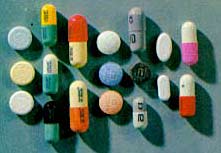The benzodiazepine family of depressants are used therapeutically to produce sedation, induce sleep, relieve anxiety and muscle spasms, and to prevent seizures. In general, benzodiazepines act as hypnotics in high doses, and as sedatives in low doses. Of the drugs marketed in the United States that affect central nervous system function, benzodiazepines are among the most widely prescribed medications and, unfortunately, the most frequently abused.
 Fifteen members of this group are presently marketed in the United States and an additional 20 are marketed in other countries. Like the barbiturates, benzodiazepines differ from one another in how fast they take effect and how long the effects last. Shorter-acting benzodiazepines, used to manage insomnia, include estazolam (ProSom), flurazepam (Dalmane), quazepam (Doral), temazepam (Restoril) and triazolam (Halcion). Benzodiazepines with longer durations of action include alprazolam (Xanax), chlordiazepoxide (Librium), clorazepate (Tranxene), diazepam (Valium), halazepam (Paxipam), lorazepam (Ativan), oxazepam (Serax) and prazepam (Centrax). Most of these are in the photo below, but since they are also available in generic forms, their appearance may vary.
Fifteen members of this group are presently marketed in the United States and an additional 20 are marketed in other countries. Like the barbiturates, benzodiazepines differ from one another in how fast they take effect and how long the effects last. Shorter-acting benzodiazepines, used to manage insomnia, include estazolam (ProSom), flurazepam (Dalmane), quazepam (Doral), temazepam (Restoril) and triazolam (Halcion). Benzodiazepines with longer durations of action include alprazolam (Xanax), chlordiazepoxide (Librium), clorazepate (Tranxene), diazepam (Valium), halazepam (Paxipam), lorazepam (Ativan), oxazepam (Serax) and prazepam (Centrax). Most of these are in the photo below, but since they are also available in generic forms, their appearance may vary.
The longer acting benzodiazepines are primarily used for the treatment of general anxiety. Midazolam (Versed) is available in the United States only in an injectable form for an adjunct to anesthesia. Clonazepam (Klonopin) is recommended for use in the treatment of seizure disorders, but is often used for sleep disorders and Fibromyalgia.
Flunitrazepam (Rohypnol), which produces diazepam-like effects, continues to be popular among young people as a drug of abuse. The drug is not marketed legally in the United States, but is smuggled in by traffickers.
 Daily use of therapeutic doses of benzodiazepines is associated with physical dependence. The withdrawal syndrome is similar to that of alcohol withdrawal and is generally more unpleasant and longer lasting than narcotic withdrawal and frequently requires hospitalization. Abrupt cessation of benzodiazepines is not recommended, and tapering-down the dose eliminates many of the unpleasant symptoms.
Daily use of therapeutic doses of benzodiazepines is associated with physical dependence. The withdrawal syndrome is similar to that of alcohol withdrawal and is generally more unpleasant and longer lasting than narcotic withdrawal and frequently requires hospitalization. Abrupt cessation of benzodiazepines is not recommended, and tapering-down the dose eliminates many of the unpleasant symptoms.
Given the number of people who are prescribed benzodiapines, relatively few people increase their dosage or engage in drug-seeking behavior. However, those individuals who do abuse benzodiazepines often maintain their drug supply by getting prescriptions from several doctors, — Elvis Presley was known for this, forging prescriptions or buying diverted pharmaceutical products on the illicit market.
 Abuse is frequently associated with teens and young adults who take benzodiazepines to obtain a “high.” This intoxicated state results in reduced inhibition and impaired judgment. When used with alcohol or other depressants with benzodiazepines can be life-threatening. Abuse of benzodiazepines is particularly high among heroin and cocaine abusers.
Abuse is frequently associated with teens and young adults who take benzodiazepines to obtain a “high.” This intoxicated state results in reduced inhibition and impaired judgment. When used with alcohol or other depressants with benzodiazepines can be life-threatening. Abuse of benzodiazepines is particularly high among heroin and cocaine abusers.
Approximately 50 percent of people entering treatment for narcotic or cocaine addiction also report abusing benzodiazepines.
If you have a parent taking these with a prescription, please do not use their medication and don’t mix them with alcohol unless you really like visiting hospital Emergency Departments.


There will be a list identifying the pills here shortly; I am so busy. For pill identification see three the Drug Photograph pages, where all these are identified.
Much of this text is used with permission from the U.S. Dept. of Drug Administration
